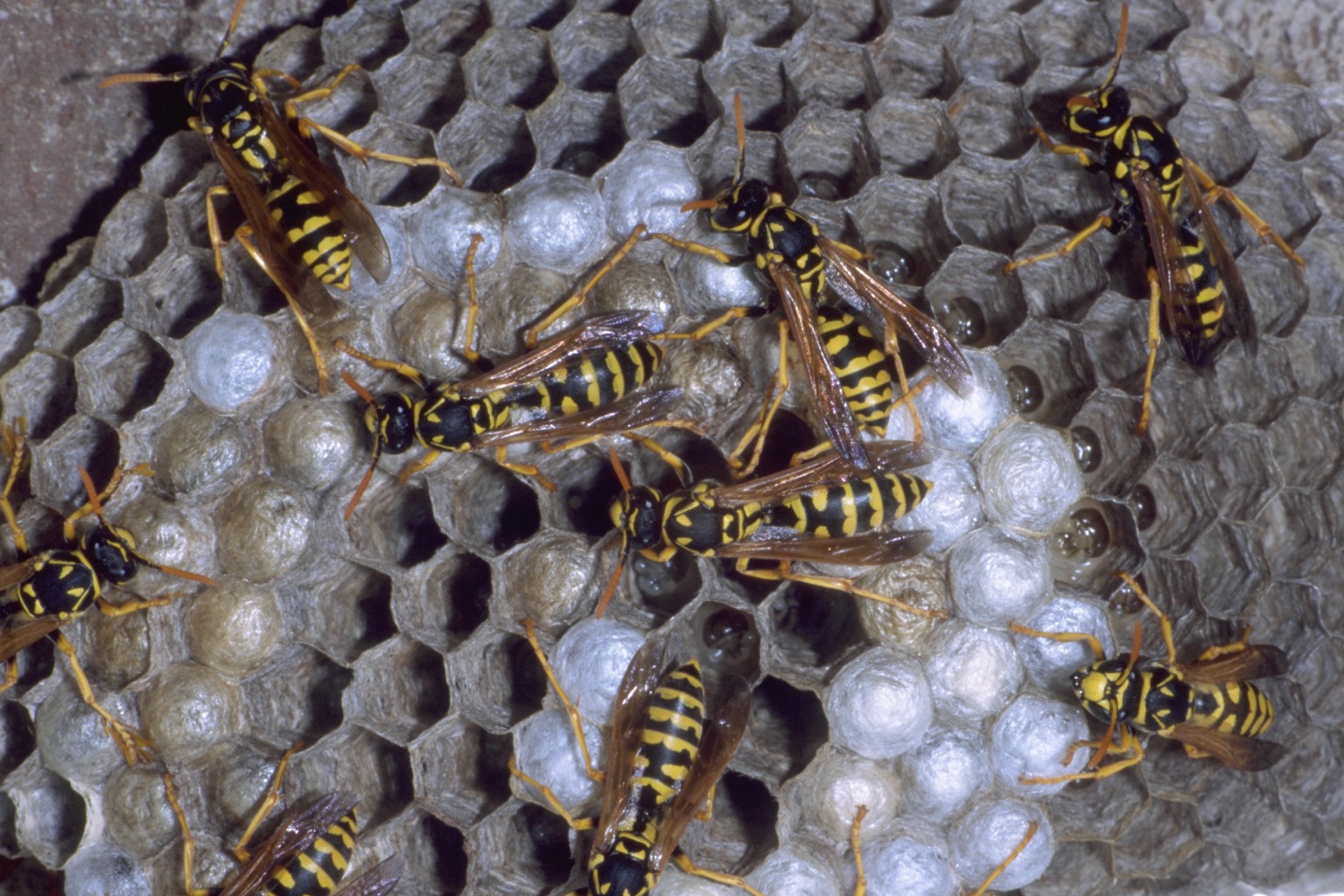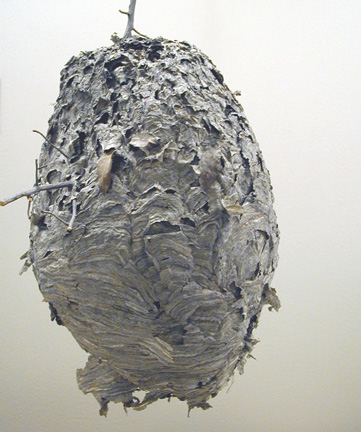Household and Structural
SOCIAL BEES AND WASPS
Timothy J. Gibb, Extension Entomologist
If you want to view as pdf, click here
Controlling bees and wasps in and around buildings, parks, and campgrounds may be difficult and possibly hazardous. Some people are hypersensitive to bee and wasp venom, and many others are greatly afraid of these common insects. Most commercial pest control operators are equipped to deal with bees and wasps and can provide service when control is warranted.
Although all female bees and wasps are capable of stinging (males are harmless), only the social species aggressively do so in defense of their colonies. Solitary species rarely sting; typically, only if mishandled. Accordingly, it is important to be able to distinguish social bees (the honey bee, bumble bees) and social wasps (paper wasps, hornets, yellowjackets) from their solitary relatives such as carpenter bees, cicada killer, mud daubers, etc. (See E-63 “Solitary Bees and Wasps: Carpenter Bee, Cicada Killer and Mud Daubers”).
Truly social bees and wasps exist in colonies associated with some type of elaborate nest. Colonies are easily recognized by the great amount of activity in and out of the single nest site. Solitary bees and wasps, although sometimes existing in aggregations, build a small burrow in which a female raises a few young by herself. Such females do not defend their solitary nests.
All bees and wasps are beneficial and should be conserved unless they cause direct damage by their nesting activity or constitute a stinging threat such as when a colony exists in or around structures and areas of much human activity. Colonies situated high in trees or in areas seldom used by people should be left alone because they are no threat.
Bees and wasps can be distinguished both by their appearance and the type of nest they build. Nearly all bees gather pollen to feed their young and possess rather hairy bodies with flattened, hairy hind legs to assist in pollen transport. In contrast, wasps capture insects to feed their young and are much less hairy. They also lack the flattened, hairy pollen basket on the hind leg.
HONEY BEES IN BUILDINGS
Honey bees may build colonies in hollow walls, chimneys, and attics of buildings. Here, they may annoy or at times sting the residents, and their colonies (unlike other social bee and wasp colonies) may be a perennial problem. In addition, the wax combs of the nest may melt and allow stored honey to seep through walls and ruin interior finishes. Abandoned honeycombs can become infested with scavenger insects or may attract rodent pests which may enter the home and cause additional annoyance. Accordingly, removal and/or destruction of honey bee colonies in structures is advised, but it should be done with special care.
Honey bee colonies in structures can be destroyed by injecting 5% carbaryl (Sevin) dust (Apicide®) into the entrance hole or a hole drilled through the wall into the nest itself. Dusts are most easily applied with a plunger type garden duster with the baffle removed and should be used according to label directions
Treatment should be done at night when bees are less active and nearly all are inside the colony. To avoid stings, wear a bee veil and gloves, and tie shirt sleeves and trouser legs. After the bees have completely disappeared, try to remove the honey and honeycomb, and close the entrance securely.
BUMBLE BEES
Large, hairy, yellow or orange and black, bumble bees are social, usually existing in small underground colonies, although some colonies are in straw or other insulating materials. Most species aggressively defend their colonies and warrant control. To control, follow recommendations mentioned for ground nesting yellowjackets.
SOCIAL WASPS: PAPER WASPS, HORNETS, AND YELLOWJACKETS
Social wasps exist in populous colonies associated with a paper nest. A colony consists of an egg-laying queen and many sterile females called workers. Social wasp colonies are annual (exist for one season only), and a nest is used only during the season it is built. Thus, the presence of a colony one season does not mean a colony will exist in the same site the following season. Although all social wasps capture insects such as flies, caterpillars, beetle larvae, etc., and thus are beneficial, destruction of colonies is warranted when located in or around structures and areas of human activity where a probability of human stings can occur.
Control should follow the same rules as with honey bees: control at night and wear adequate protective clothing with veil and gloves. A flashlight covered with red cellophane should be used when applying insecticide at night. Although small, early season colonies and most undergound colonies are easily controlled, above-ground and nearly all structural colonies are best handled by professional pest control operators unless the person attempting control is knowledgeable about social wasps.
Adult worker yellowjacket.
Yellowjacket ground nest.
Paper Wasps: These slender, long-legged wasps exist in small colonies associated with a single, exposed nest comb that typically is suspended from eaves or in outbuildings.
Typical paper wasp nest.
European Paper Wasps (Dominulus) have recently become very common in Indiana. These paper wasps often build nests inside enclosed voids of lighting fixtures, bird boxes, gas grills, motor homes, boats and other infrequently used spaces. This often creates unexpected encounters with people and has let to an increase in stings to people. Colony destruction is best accomplished with any number of pressurized products containing quick knockdown materials such as resmethrin and synergized pyrethrins (Wasp Freeze®, Wasp Stopper®, Bee Bopper®, etc.). Stand well away from the colony and completely soak the nest material. Remember that paper wasps are highly beneficial caterpillar predators and relatively nonaggressive. Therefore, avoid controlling them unless colonies present a direct stinging threat.
European paper wasp (Polistes Diminulus).
Baldfaced Hornet: This large black and white species builds the familiar large, grayish, pear-shaped nest that typically is suspended in trees or on sides of buildings. The thick paper envelope encloses two or four horizontally arranged combs. Late summer colonies may be quite large, consisting of nearly a thousand workers. Most nests should be left alone, however, if warranted, control is best left to a professional pest control operator. Protective gear and quick, efficient insecticide application is imperative.
Nest of the baldfaced hornet.
Sprays should be directed into the nest entrance (typically located near the bottom of the nest), and the entire nest should be thoroughly soaked. Many pressurized products for home insect control are not effective. Look for products with synergized pyrethrins plus petroleum distillates (e.g., Wasp Freeze®) which freezes the wasps upon contact. Colonies situated high in trees far from human activity should be left alone.
Ground-Nesting Yellowjackets: Several species of yellowjackets exist in Indiana, and most build subterranean nests (similar in architecture to baldfaced hornet nests) in such areas as creek banks, the forest floor, lawns, and garden and flower beds. Late-season colonies can be very large, consisting of a few thousand workers. When located in home, yards, and gardens, colonies usually warrant control since people may inadvertently step on them or disturb them indirectly while gardening or mowing grass.
Control usually is safely and effectively accomplished by applying an insecticide directly down the entrance hole in the soil after dark. Always walk carefully around the the nest site, since many colonies are situated just below the soil surface or immediately beneath leaf litter, and thus may be very easily disturbed or stepped into.
Structural Nesting Yellowjackets and European (Giant) Hornet: Similar to the honey bee, some yellowjackets (typically the German yellowjacket) and the European hornet may build their colonies inside structures (inside wall voids, attics, and sometimes basements). Control of such colonies is best left to a professional pest control operator. Colonies can be very large and are often located far from the entrance hole, deep into the structure. In most cases, special application equipment is needed to insure that the insecticide penetrates deep into the structural void and contacts the colony. For such difficult control situations the services of a professional exterminator should be obtained.
Additional Control Considerations: Often yellowjackets and honey bees scavenge for sugar or meat during late summer and fall. These wasps become nuisances at picnics and other outdoor events. One of the best methods of reducing contact with yellowjackets in urban, residential, and recreational areas is to keep foods covered until immediately prior to consuming them. In addition, remove and handle garbage in such a way as to make it less available to foraging yellowjackets. Garbage should be cleaned up regularly, and receptacles should have tight-fitting lids. During periods of heavy yellowjacket activity, trash receptacles should be re-located away from open doors or where people congregate.
A number of traps incorporating meat baits or artificial attractants are available for sale in Indiana. However, these are largely ineffective for truly controlling social wasps. Such products are not recommended for use.
READ AND FOLLOW ALL LABEL INSTRUCTIONS. THIS INCLUDES DIRECTIONS FOR USE, PRECAUTIONARY STATEMENTS (HAZARDS TO HUMANS, DOMESTIC ANIMALS, AND ENDANGERED SPECIES), ENVIRONMENTAL HAZARDS, RATES OF APPLICATION, NUMBER OF APPLICATIONS, REENTRY INTERVALS, HARVEST RESTRICTIONS, STORAGE AND DISPOSAL, AND ANY SPECIFIC WARNINGS AND/OR PRECAUTIONS FOR SAFE HANDLING OF THE PESTICIDE.
April 2018

It is the policy of the Purdue University Cooperative Extension Service that all persons have equal opportunity and access to its educational programs, services, activities, and facilities without regard to race, religion, color, sex, age, national origin or ancestry, marital status, parental status, sexual orientation, disability or status as a veteran. Purdue University is an Affirmative Action institution. This material may be available in alternative formats.
This work is supported in part by Extension Implementation Grant 2017-70006-27140/ IND011460G4-1013877 from the USDA National Institute of Food and Agriculture.
1-888-EXT-INFO
www.extension.purdue.edu
Order or download materials from www.the-education-store.com







